Art & Exhibitions
David Ebony’s Top 10 New York Gallery Shows This Winter
Here's what to see before spring.
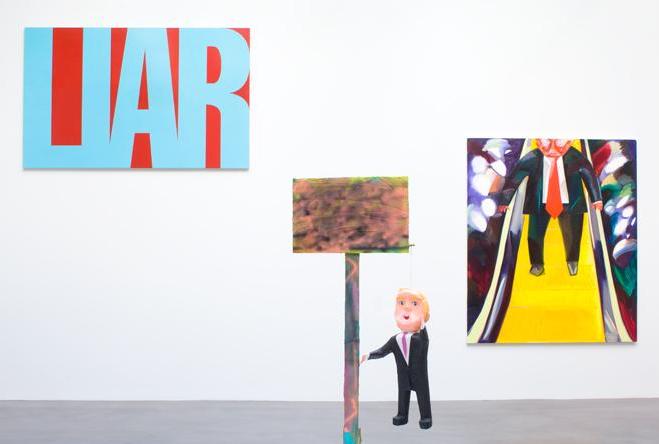
Here's what to see before spring.

David Ebony

1. “We need to talk… Artists and the public respond to the present conditions in America,” at Petzel Gallery, through February 11.
This winter ushered in a new political climate of distressing ironies, in which, for instance, modestly compensated journalists, writers, editors, artists, filmmakers, performers, and other cultural workers may be regarded as “the elite,” while billionaire oligarchs appear to have successfully positioned themselves as “just plain folks,” attuned to the needs of the middle class and the poor. Rather than merely an initiative of alternate facts, there appears to be in development an alternate reality of skewed values and judgments. How did this happen? By means of projects like this engaging group show at Petzel, the art world may be able to provide, or at least suggest some answers. The gallery should be commended for preempting its scheduled winter program in order to initiate these important and timely discussions, including a series of Saturday symposiums dealing with civil liberties, immigration, and the environment.
Among many other queries, “We need to talk…” tackles the question, what does it mean to be a populist? Artists such as Jonathan Horowitz, Sean Landers, Glenn Ligon, Joyce Pensato, Peter Saul, Dirk Skreber, and Slavs and Tatars, and others, working in a wide variety of mediums, attempt to answer. They take direct aim at the new administration in Washington D.C., holding it responsible from the outset for its ongoing lies and deceptions. A painting by Sarah Morris, Liar, describes the man in the oval office, a position that was once an aspiration for children everywhere, but is now simply the model for a festive piñata, at least in a sculpture by Rachel Harrison. Visitors to the show are welcome to contribute videos, and written comments. There is a feeling of urgency here, not a little bit of anger, but also a great deal of humor. An overall conciliatory tone prevails, but the alarm has been sounded and the message is clear.
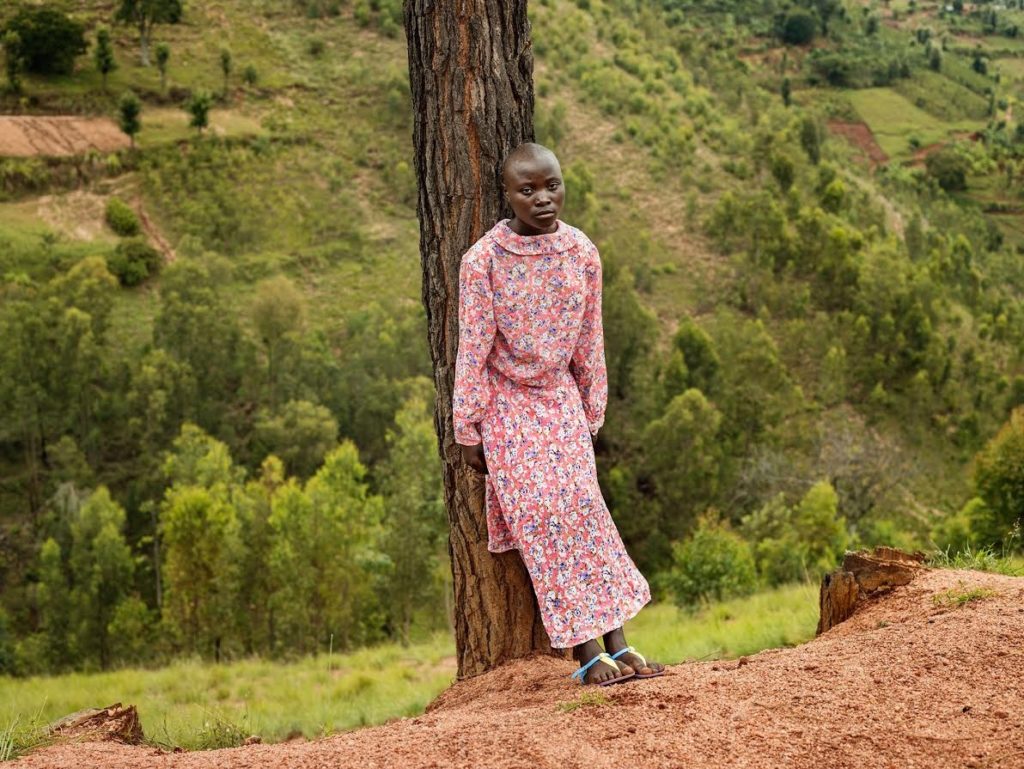
Pieter Hugo, Portrait #9 Rwanda, 2015. Photo Courtesy Yossi Milo Gallery.
2. Pieter Hugo at Yossi Milo Gallery, through March 11.
For the past fifteen years or more, South African artist/photographer Pieter Hugo has been documenting under-known areas of Africa from a unique insider’s point of view. His 2007 series of photos, for example, focused on street performers in Nigeria, collected in one of my all-time favorite photography books, The Hyena and Other Men. This series explores a tradition and way of life in a manner that demonstrates a highly aestheticized and ultrasensitive approach to an extraordinary subject. Born in 1976 in Johannesburg, and currently a resident of Cape Town, Hugo has lately turned his attention to the children of Rwanda and South Africa.
This exhibition, “1994,” features large, recent color photographs of children born after 1994, the year of Rwandan genocides and the end of Apartheid in South Africa. Most of these gorgeous images show healthy children and adolescents posing for the camera in idyllic settings. Only after reading some of the press materials does one learn that the bucolic scenes were once the staging areas for horrific crimes against humanity. In Portrait #9 Rwanda, a girl leans against a tree just above a verdant ravine. The only note of discord in the picture is the oversize dress she wears, a European donation. Another outstanding work, Portrait #44 South Africa shows a young woman in a pink dress lounging in a shallow pool of water. The ambivalent expression on her face, though, is far from playful. Despite the beauty of the image, the scene retains a hint of menace from a bygone era, the likes of which hopefully will never return.
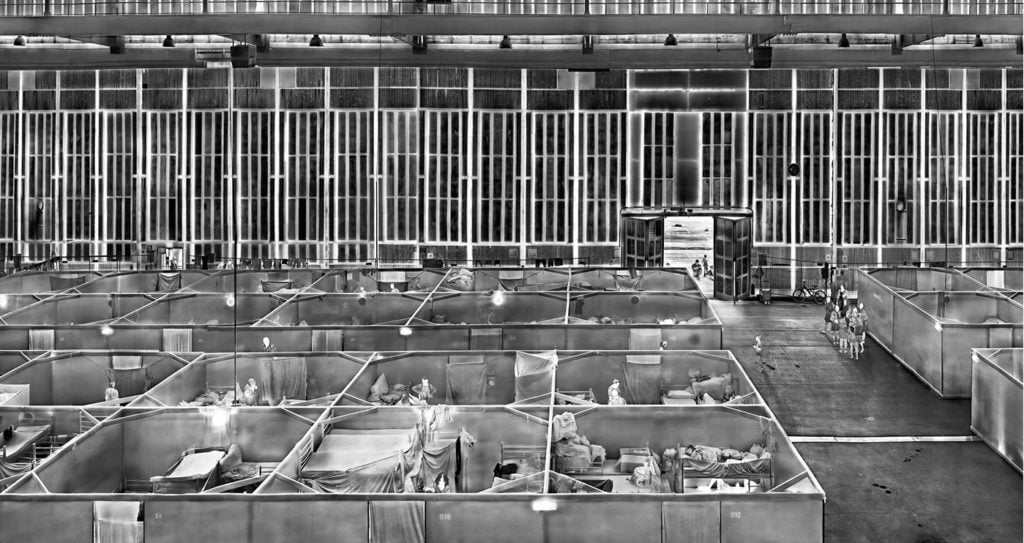
Richard Mosse, Tempelhof Interior, 2016. Photo Courtesy the artist and
Jack Shainman Gallery.
3. Richard Mosse at Jack Shainman Gallery, through March 11.
In his previous shows of large-scale photos, Irish artist/photographer Richard Mosse used infrared film to document the atrocities of the war in the Eastern Congo. The film, once used by military surveillance crews, transposes the color of foliage, uniforms, and all things green, to pink, fuchsia or lavender in the pictures. The visual splendor of the photos belies their horrific content. Mosse’s new series of works, “Heat Maps,” is similarly visually sumptuous and thematically disconcerting. The large-scale black-and-white panoramic images show European refugee camps, taken with a military grade, telephoto camera that can detect thermal radiation, including body heat, from great distances, sometimes as far as a mile away or more.
In Idomeni Camp Greece, soldiers guard a long line of refugees from Syria and other Middle Eastern countries entering the darkened confines of the military compound. This is the same camp that inspired recent works by Ai Weiwei, who collected the discarded clothing and other items the refugees left behind, reusing them for several powerful installations. In his work, Mosse presents an image of hushed serenity and almost classical dignity, despite the ominous and heart-wrenching nature of the scene. Tempelhof Interior shows the Berlin airport holding areas where refugees are detained and processed. Though offering the hope of shelter, or some relief from desperation, it is a forbidding place, prison-like in its cold and calculating purpose.
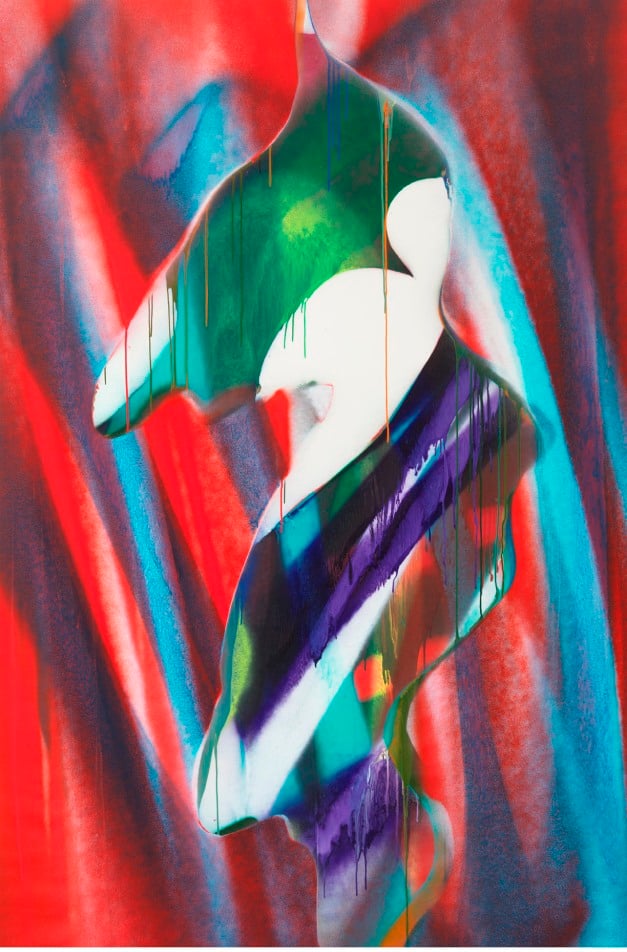
Katharina Grosse, Untitled, 2016. ©Katharina Grosse and VG Bild-Kunst, Bonn.
Photo by Jens Ziehe. Courtesy Gagosian Gallery.
4. Katharina Grosse at Gagosian Gallery, through March 11.
It is something of a surprise that Katharina Grosse is making her New York City gallery debut, at Gagosian no less, with large, conventional-format paintings on canvas, averaging over ten-by-eight feet. She has always created 2-D works, but the internationally renowned German artist, based in Berlin, is best known for enormous painted environments, sometimes employing cranes and industrial spray-paint equipment to produce vast installations that merge the disciplines of painting, sculpture, and architecture. Last year, her red- and magenta-painted derelict beach structure, Rockaway!, caused a stir, and inspired awe in those who made the pilgrimage to its site-specific, Brooklyn seaside location. Filling a small side gallery at Gagosian, one of her painted cast metal sculptures appears as a fanciful piece of driftwood that might well have been part of the Rockaway! installation.
Grosse’s decision to present here, almost exclusively, paintings in the heroic scale of Abstract Expressionism, indicates that the artist likely conceived the exhibition as a direct dialogue with the New York School, an homage to its towering contribution to international painting, and, on a personal level, to its influence on her own art. Considered in the context of those formidable art-historical terms, Grosse’s effort succeeds on many levels. She engages the hallowed, painterly idioms and rhythms of Pollock and Rothko, while addressing the subtle nuances of layering, spatial relationships, and atmosphere associated with the work of Color Field painters like Morris Louis and Helen Frankenthaler. Each of the sixteen untitled paintings by Grosse on view, all 2016, encompasses a dramatic interaction of color and gesture, a play of depth and perspective that pushes the boundaries of what abstract painting can do, or can be.
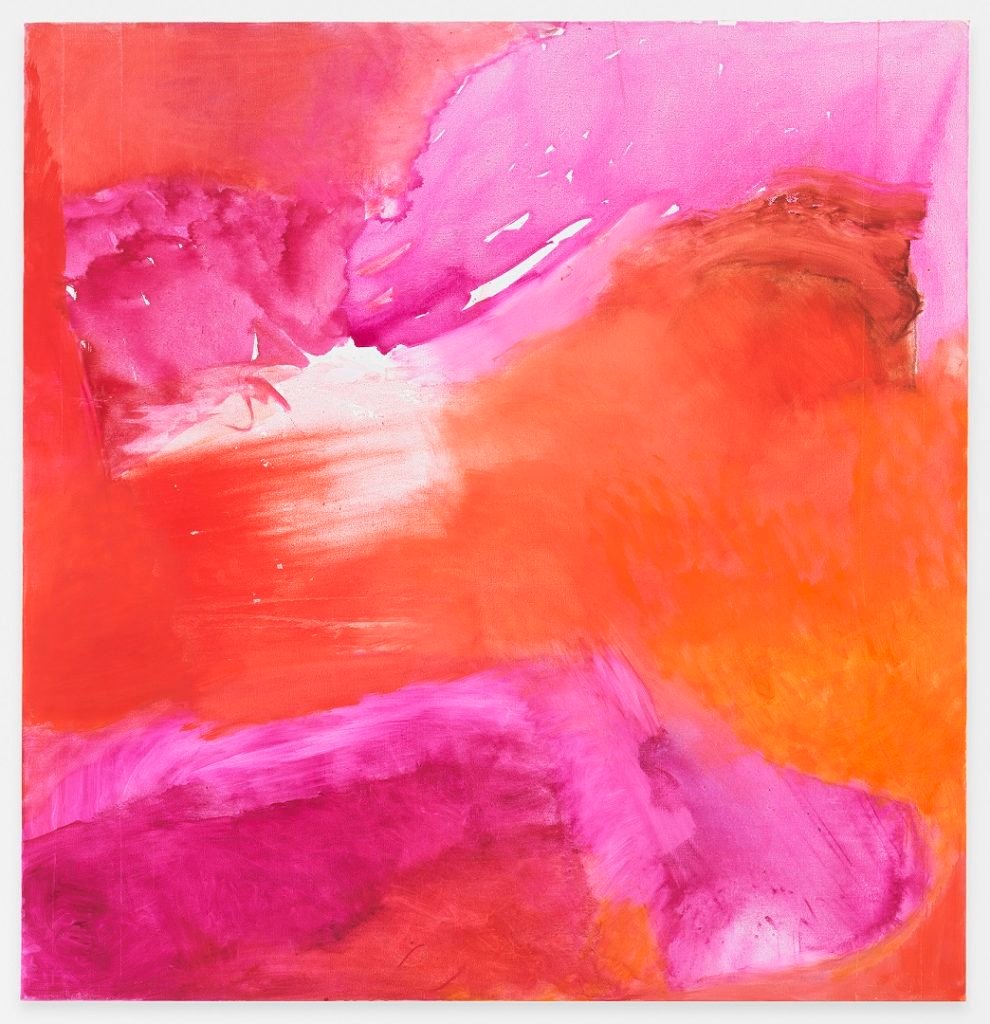
Emily Mason, Breath of Fresh Air, 2016
Photo Courtesy Ameringer McEnery Yohe Gallery.
5. Emily Mason at Ameringer McEnery Yohe, through February 11.
While a younger generation of artists, led by Katharina Grosse, Carol Bove, and others, are finding renewed significance and surprising rewards in extemporaneous abstract painting and sculpture, certain veterans like Emily Mason never lost faith in their limitless possibilities. Mason is heir to a long lineage of artistic forebears, perhaps most notably her mother, Alice Trumbull Mason, who was a founding member of the American Abstract Artists group in the mid-1930s. Emily’s childhood memories include visits from Mondrian, and watching Miró paint in a studio adjacent to her mother’s. Painting was in her blood, but she diverged from her mother’s penchant for hard-edge abstraction, and instead gravitated in the 1950s toward a more informal, intuitive process centered on color relationships and fluid gestures, which she has been developing and refining ever since. Her expansive and elusive compositions in some way establish a vital link between Abstract Expressionism and Color Field painting.
The luminous and youthfully hyper-energetic paintings by Emily Mason in this show, which hardly seem to be the work of an octogenarian, are among the best of her long career. The color red is widely regarded by painters as a particularly difficult color to control. Mason seems to relish the challenge here in large canvases such as Rush Hour, Pressure Point and Breath of Fresh Air, in which passages of subtly shifting analogous tones of orange-red, magenta, and pink collide and commingle in not-so-subtle, heightened degrees of dynamic tension. Intense, contrasting touches of blue and turquoise punctuating the warm, ethereal clouds of color in Renewable and Sailor’s Delight, further activate Mason’s distinctive, cosmic space.
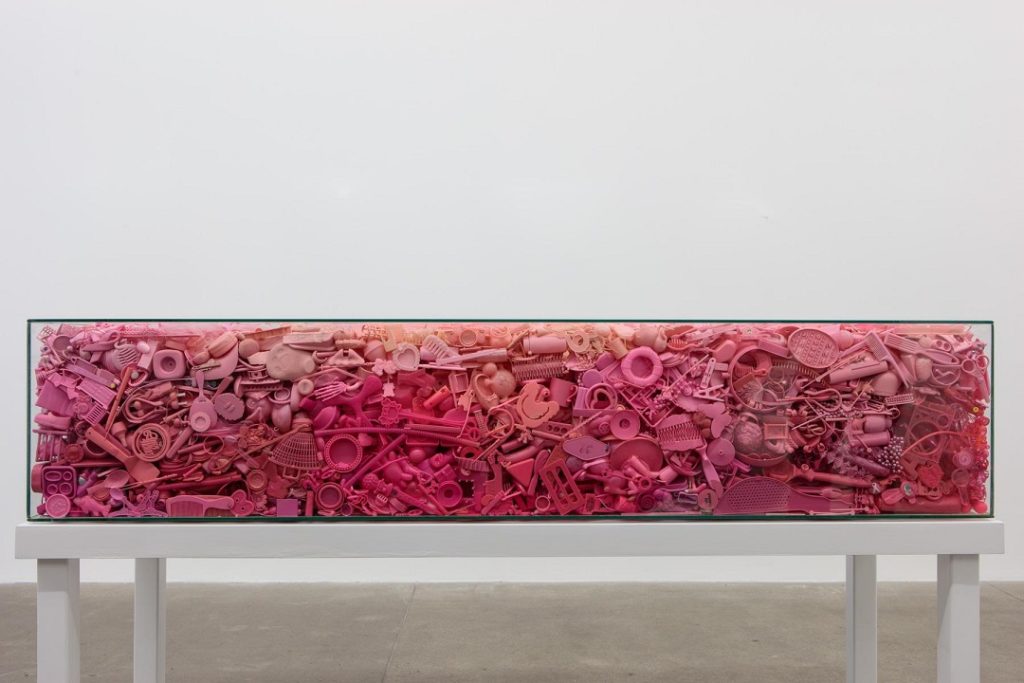
Portia Munson, Her Coffin,(detail), 2016.
Photo Courtesy P.P.O.W.
6. Portia Munson at P.P.O.W., through February 11.
The wide conceptual range of Portia Munson’s art matches its technical diversity. “The Garden” is a dazzling show of works spanning more than two decades, including paintings, freestanding assemblage sculptures, and an inhabitable installation that resembles a wildly over-stuffed living room, also titled The Garden. The two core themes of her endeavor, feminism and environmental issues, are stressed throughout the exhibition in some novel, and often unexpected ways. The small paintings on view are more-or-less realistically painted still lifes, centralized compositions of objects associated with girls—dolls, wigs, hair-clips, and the like—with a predominance of the color pink. A photo series, featuring images of dead birds surrounded by flowers in full bloom, appears as an elegiac ode to the precarious fragility of nature.
One of the most arresting pieces, Her Coffin, is a glass vitrine crammed with thousands of pink plastic objects, like those that mostly girls or young women might accumulate over the course of many years. At first, the sarcophagus-size glass box, placed upon a white-painted table, looks like an imposing Minimalist sculpture, countering the baroque excess of the rest of the show. On closer viewing, the cacophonous collection of pink junk constitutes an acerbic comment on consumerism, as well as a personal meditation on the nature of life and death. At once playful and provocative, Munson, in this work, poses the unsettling question: in the end, is an individual merely—or profoundly—the sum of all the objects and experiences, “the stuff,” that she or he has accumulated over the course of a lifetime?
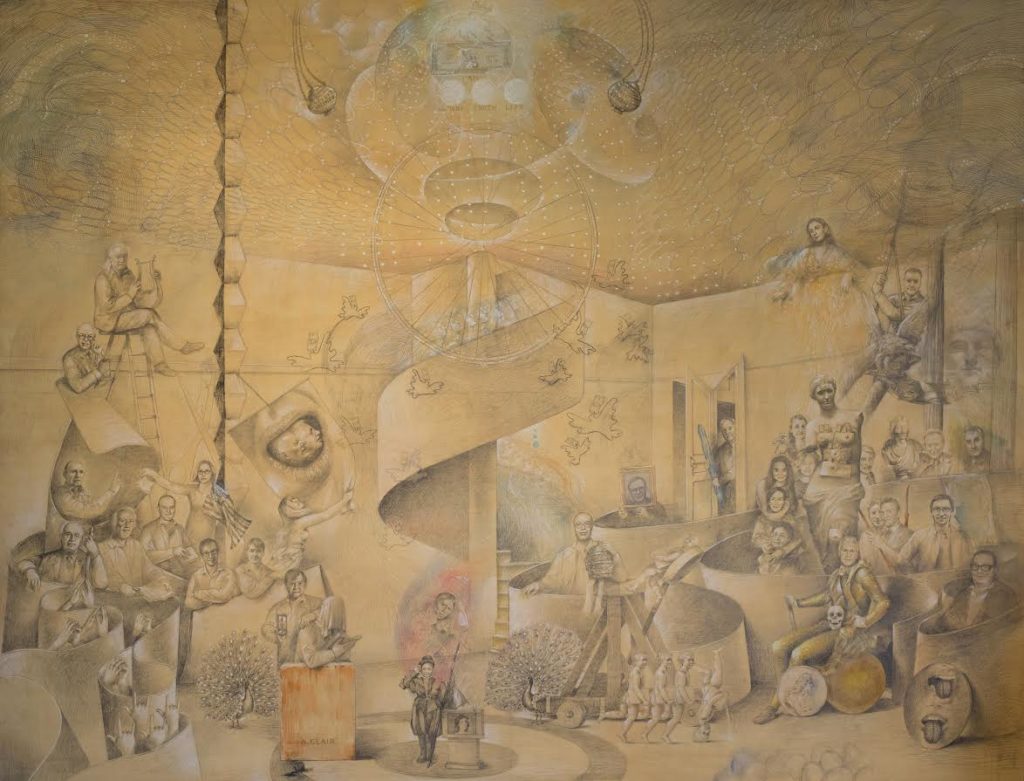
Carlo Maria Mariani, A Flight of Doves, 2012-16.
Photo Courtesy the artist and Francis M. Naumann Gallery.
7. Carlo Maria Mariani at Francis M. Naumann Gallery, through February 18.
In “A Flight of Doves,” Carlo Maria Mariani takes a long, hard look at the New York art scene, and the state of art today. The show’s centerpiece, and eponymous work, is a large (approximately six-by-eight foot) canvas featuring meticulously rendered portraits of thirty well-known dealers, curators, art writers, and critics, who have had some impact, either directly or indirectly, on the reclusive Italian-born, New York-based artist’s life and career. Painted in acrylic, gouache and graphite, this extraordinary composition resembles a large cartone, like the kind early Renaissance masters would use as preparatory drawings for large-scale murals. The show also contains a selection of Mariani paintings and drawings from the past two decades.
In A Flight of Doves, the principal figures are arranged alongside what appear to be Richard Serra steel sculptures. These objects flank a towering, spiraling staircase that dominates the center of the composition like a compressed version of the Guggenheim Museum’s ramp. On the left, American critics and curators gather. Images of Dan Cameron, Roberta Smith, Robert Pincus-Witten, and others appear beside European players like Achille Bonito Oliva, Jean Clair, and Germano Celant. To the right of the staircase are some prominent dealers, including Gian Enzo Sperone and Angela Westwater, who represented Mariani early in his career, as well as Mary Boone, Larry Gagosian, and Michael Werner, among others. At bottom center is a self-portrait of Mariani at six years old, and an image of a youngster in a catapult—ostensibly receiving an art-world launch early in his career. Circling the staircase, a flock of doves, representing collectors, each carry a dollar bill in its beak. Here, Mariani’s acerbic wit and sarcasm convey a disparaging view of the cash-fueled art establishment. On some level, though, this lovingly rendered composition may also be regarded as a tribute to an art world that has periodically nurtured and sustained him.
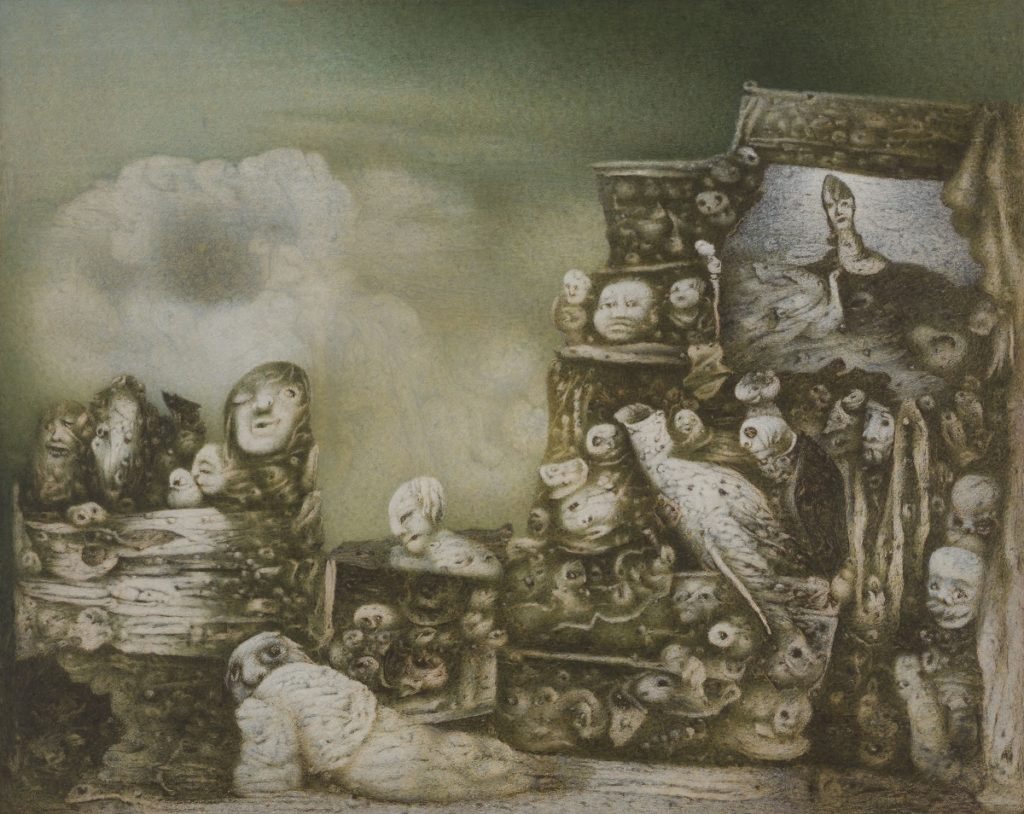
Richard Oelze Valley of Josaphat 1969/70.
Photo Courtesy Michael Werner Gallery.
8. Richard Oelze at Michael Werner, through March 11.
Hailed by André Breton and others denizens of the mid-20th century avant-garde as one of the best Surrealist painters, the German artist Richard Oelze (1900-1980) is unfortunately under-known in the United States. Hopefully, this show of some two dozen major canvases and a selection of drawings will change the situation. The show must be seen in person to be fully appreciated. The textural nuances in the work are difficult to reproduce, and the haunted atmosphere that the artist conjures in each of these images seems to reveal itself only with intimate and sustained viewing.
Oelze lived in Dresden and studied at the Bauhaus in Dessau. But he blossomed as an artist after 1933, the year he moved to Paris and fell in with the Surrealists. His output soon reflected a kinship with works by Max Ernst and Hans Bellmer, but Oelze’s vision remained singular, eccentric, and obsessive. Drafted by the German army during World War II, he was captured and imprisoned by the Allies until the war’s end. After being released in 1945, he settled in northern Germany and resumed painting. Though impoverished and increasingly reclusive in subsequent decades, Oelze began to produce his best works, such as If by Another Beauty (1958), After the Narration of a Dream (1961), and Valley of Josaphat (1969/70), among the show’s many highlights. Over the years, he refined a type of baroque, quasi-abstraction in which inert landscape features, like rocks, trees, and shrubbery transmogrify into writhing, restless beings. It’s fair to say that Oelze’s work is well suited to the mood of the present moment. If there is such a thing as hopeful foreboding, this is it.
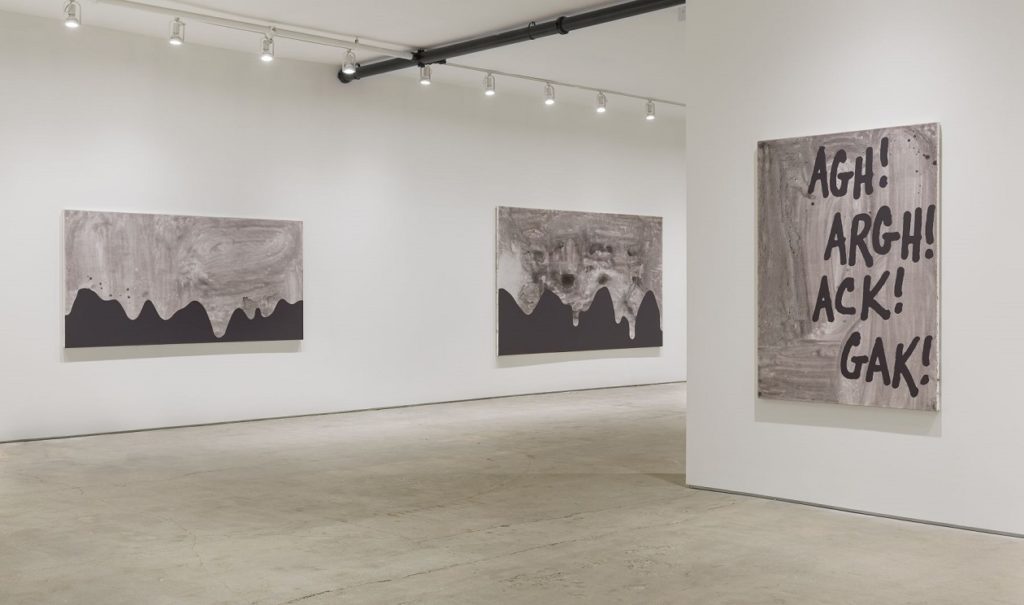
Installation view, Carl Ostendarp. 2017.
Photo Courtesy Elizabeth Dee Gallery.
9. Carl Ostendarp at Elizabeth Dee, through February 25.
In the press release for this show of recent paintings, Massachusetts-born, New York artist Carl Ostendarp states that “The exhibition as a whole is intended as a response to the social, political and psychological state of society, not an expressionist gesture, but as an expression.” All of the large canvases on view are painted with similar gray tones, to reference news print, documentary film, and photography. Some of the works here pointedly convey the artist’s disgust and outrage of the moment, especially the text pieces, Ech! and Arh! Argh! Ack! Gak! (both 2016).
Also on view are a number of grisaille abstracted landscape images with dense, muted gray grounds of rolling hills spanning the lower portions of the large canvases (up to six-by-twelve feet). Dominating the upper area of each of these compositions, such as Behind the Wall of Sleep and Planet Caravan, hyperactive whooshes of translucent gray pigment, applied with mops, suggest a celestial evening reverie. Despite the Goya-esque tones and atmosphere of gloom, these cosmic vistas offer some element of hope and primordial wonder.
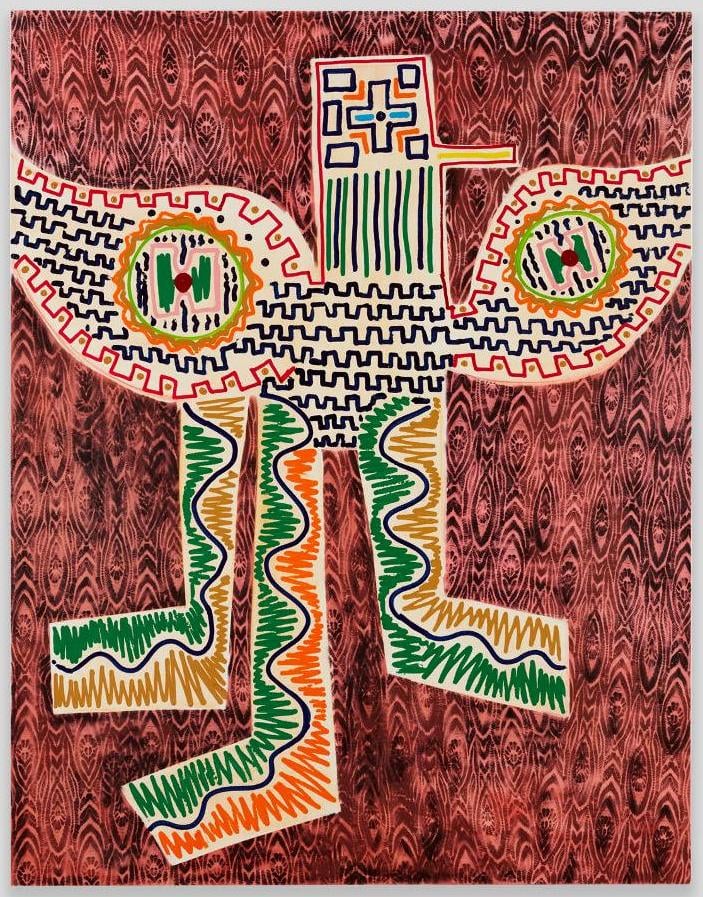
Tamara Gonzales, I am the Hummingbird, 2016.
Photo Courtesy Klaus von Nichtssagend Gallery,
10. Tamara Gonzales at Klaus von Nichtssagend Gallery, through February 12.
California-born, New York-based artist Tamara Gonzales finds inspiration in pre-Colombian art, and has recently been working with Peruvian weavers to create a series of medium-size colorful tapestries that pay homage to Inca and Shipibo textiles and design. Hung together in one gallery, they are among the many highlights of “Ometeotl,” whose title refers to the ancient Mesoamerican word for dual energies. The exhibition also features large-scale paintings, works on paper, and a single sculpture, Maraca más grande con plumas (Large Maraca with Feathers). This absurd and wonderful eleven-foot-tall maraca leans against the wall at the gallery entrance.
A recurring image in Gonzales’s work is a kind of blocky, stylized stick figure, which references Peruvian ayahuasca-related embroidery. The shape reappears in various incarnations in many of the playful works on paper. This type of ancient imagery and patterning was traditionally part of a spiritual and healing lexicon developed by a shaman with the help of a hallucinogenic ayahuasca drink. Gonzales updates the imagery in works like the large acrylic- and spray-paint composition, I am the Humming Bird, adopting the form for her own extensive and adventurous iconography.
David Ebony is a contributing editor of Art in America and a longtime contributor to artnet.